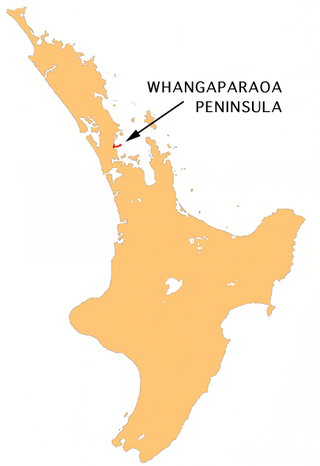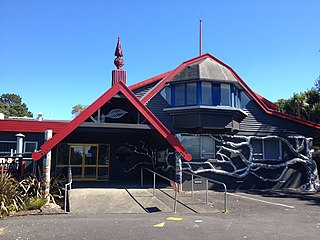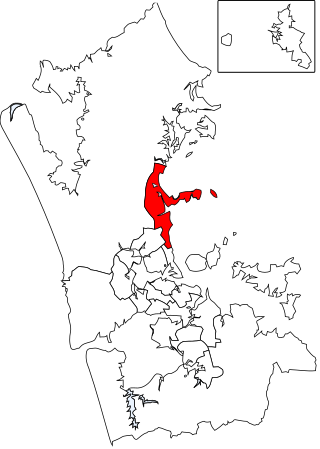Related Research Articles

Orewa is a settlement in the northern Auckland Region of New Zealand. It is a suburb of the Hibiscus Coast, just north of the base of the Whangaparāoa Peninsula and 40 kilometres (25 mi) north of central Auckland. The Northern Motorway, part of State Highway 1, passes just inland of Orewa and extends through the twin Johnston Hill tunnels to near Puhoi.

The Whangaparāoa Peninsula is a suburban area about 30–50 km north of Auckland, New Zealand. It had 39,140 residents in June 2024. It stretches from Red Beach, where it connects to Kingsway, Orewa and Silverdale, and extends to Army Bay in the Hauraki Gulf. It is part of the Hibiscus Coast. The area is populated by residents who work on the peninsula, or commute from the area to other parts of the Hibiscus Coast, the North Shore, Rodney district, Auckland CBD and beyond for work. They travel by vehicle, or via the Gulf Harbour ferry at Gulf Harbour Marina, or the Hibiscus Coast Bus Station at Silverdale. There is one main road along its entire length, which is accessible from State Highway 1 via Hibiscus Coast Highway at Silverdale, or from Hibiscus Coast Highway at Orewa via Red Beach. It is popular as a tourist destination for catching a ferry to Tiritiri Matangi Island, and for visiting Shakespear Regional Park. It has one open (Whangaparāoa Golf Club) and one closed golf club (Gulf Harbour Country Club), beaches, sporting and recreation facilities, a library, shops, businesses and public and private primary and secondary schools. The median age of the population is in the 30s-40s.

Browns Bay is one of the most northernmost suburbs in the contiguous Auckland metropolitan area, located in the North Shore. Named after the Brown family who settled here in 1876, Browns Bay became a holiday destination in the late 19th century. The area gradually developed into a suburb of Auckland in the 1950s, and was the administrative centre for the East Coast Bays City from 1975 until it was disestablished in 1989. During the 1990s, the suburb became a hub for the South African New Zealander community.

Mairangi Bay is a coastal suburb of North Shore, Auckland, located in the northern North Island of New Zealand, on the south-east-facing peninsula forming the northern side of the Waitematā Harbour. Mairangi Bay came under the local governance of the North Shore City Council until subsumed into the Auckland Council in 2010.

The Hibiscus Coast is a populated area on a stretch of the Hauraki Gulf coast in New Zealand's Auckland Region. It has a population of 69,070, making it the 10th most populous urban area in New Zealand, and the second most populous in the Auckland Region, behind Auckland itself. As an urban area delineated by Statistics New Zealand, the Hibiscus Coast consists of Hatfields Beach, Orewa, Silverdale and Whangaparāoa Peninsula. The Auckland Council's Hibiscus Coast subdivision of the Hibiscus and Bays includes the neighbouring communities of Waiwera and Stillwater, and Milldale in Rodney, is also described as a part of the Hibiscus Coast.

Rothesay Bay is a small suburb in Auckland's East Coast Bays region. The suburb is roughly the same size as Murrays Bay, the suburb to the immediate south.

Stillwater is a village in the northern end of Auckland in the North Island of New Zealand. Situated on the Weiti River immediately south of the Whangaparaoa Peninsula in the Rodney District, it is part of the area known as the Hibiscus Coast. There is also a Stillwater, West Coast in the South Island.
O Mahurangi Penlink, is a 7-kilometre-long (4.3-mile), two-lane future state highway. Construction began in late 2022 and is expected to conclude in late 2027. Once completed the new state highway will create a more direct and quicker route between the Whangaparāoa Peninsula and central Auckland in New Zealand.
John Law is a former Mayor of the Rodney District Council, New Zealand, and held that post from 2001 to 2007. He was elected during a by-election, following a period of instability in the leadership and governance of Rodney District Council. He was one of the seven mayors heading the main local government entities generally considered as making up the Auckland metropolitan area, with his district being one of the largest districts and the northernmost entity. John Law was re-elected in 2004, but did not stand for re-election in 2007.

Rodney was a New Zealand parliamentary electorate, returning one Member of Parliament to the House of Representatives. The last MP for Rodney was Mark Mitchell of the National Party. He held this position from 2011 until the electorate was replaced with Whangaparāoa in 2020. Mitchell stood for and won that seat.

Red Beach is a suburb surrounding the beach of the same name on the Hibiscus Coast, Auckland, New Zealand, at the base of the Whangaparaoa Peninsula. The suburb of Silverdale is to the south-west, and Orewa to the north.
Manly is a suburb on the Whangaparaoa Peninsula, towards the northern end of Auckland, New Zealand. Manly Village is an established shopping centre, with the residential areas of Big Manly Beach to the north and Little Manly Beach to the south. The area was once a seaside holiday location, but has become residential suburbs within commuting distance of central Auckland city.

Auckland Council is the local government council for the Auckland Region in New Zealand. It is a territorial authority that has the responsibilities, duties and powers of a regional council and so is a unitary authority, according to the Local Government Act 2009, which established the council. The governing body consists of a mayor and 20 councillors, elected from 13 wards. There are also 149 members of 21 local boards who make decisions on matters local to their communities. It is the largest council in Oceania, with a $3 billion annual budget, $29 billion of ratepayer equity, and 9,870 full-time staff as of 30 June 2016. The council began operating on 1 November 2010, combining the functions of the previous regional council and the region's seven city and district councils into one "super council" or "super city".

Rodney Ward is a local government area in the northernmost part of New Zealand's Auckland Region, created along with the Auckland Council in 2010. The area was previously part of Rodney District; it does not include the Hibiscus Coast, which was also part of Rodney District but is now in Albany ward. The Rodney Local Board area has the same boundaries as Rodney Ward.
Wayne Desmond Walker is a New Zealand politician who is an Auckland councillor.
The 2016 Auckland local elections took place between September and October 2016 by postal vote. The elections were the third since the merger of seven councils into the Auckland Council, which is composed of the mayor and 20 councillors, and 149 members of 21 local boards. Twenty-one district health board members and 41 licensing trust members were also elected.

Alan Gregory Sayers is an entrepreneur, author and a New Zealand politician who is an Auckland Councillor.

Albany Ward is an Auckland Council ward which elects two councillors and covers the Hibiscus and Bays and Upper Harbour Local Boards. The two councillors are currently John Watson and Wayne Walker.

The Hibiscus and Bays Local Board is one of the 21 local boards of the Auckland Council. It is one of two boards overseen by the council's Albany Ward councillors. The board consists of eight members elected at large.
The 2019 Auckland local elections took place between September and October 2019 by postal vote as part of nation-wide local elections. The elections were the fourth since the merger of seven councils into the Auckland Council, which is composed of the mayor and 20 councillors, and 149 members of 21 local boards. Twenty-one district health board members and 41 licensing trust members were also elected.
References
- 1 2 3 "John Watson". Putting People First. Archived from the original on 7 July 2015. Retrieved 10 July 2015.
- 1 2 "Albany Ward – John Watson". Localmatters. 16 September 2010. Archived from the original on 11 July 2015. Retrieved 10 July 2015.
- ↑ Walters, Laura. "Rates hike for some Aucklanders". Auckland Now. Stuff.co.nz . Retrieved 10 July 2015.
- ↑ "Putting People First". Putting People First. Retrieved 10 July 2015.
- ↑ "John Watson – People & Penlink First". Peopleandpenlinkfirst.co.nz. Archived from the original on 11 July 2015. Retrieved 10 July 2015.
- ↑ Orsman, Bernard (25 July 2014). "Auckland Councillors keep travel perk". The New Zealand Herald . Retrieved 10 July 2015.
- ↑ Sergel, Michael (25 June 2015). "Auckland Council approves controversial new budget". Newstalk ZB . Retrieved 10 July 2015.
- ↑ Watson, John (17 March 2015). "John Watson: Stadium policy should be knocked for six". The New Zealand Herald . Retrieved 10 July 2015.
- ↑ Slade, Maria (25 June 2015). "Auckland's Long Term Plan budget is passed". Stuff.co.nz . Retrieved 10 July 2015.
- ↑ "Archived copy" (PDF). www.aucklandcouncil.govt.nz. Archived from the original (PDF) on 19 October 2016. Retrieved 14 January 2022.
{{cite web}}: CS1 maint: archived copy as title (link) - ↑ "2019 local elections final results – Mayor, ward councillors, local board members" (PDF). Retrieved 9 October 2022.
- ↑ "Ward councillor progress results" . Retrieved 9 October 2022.